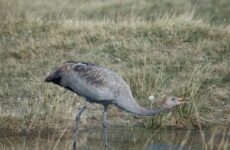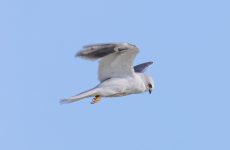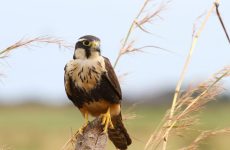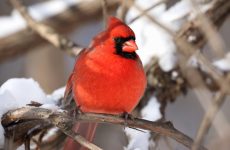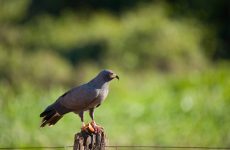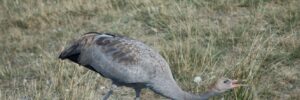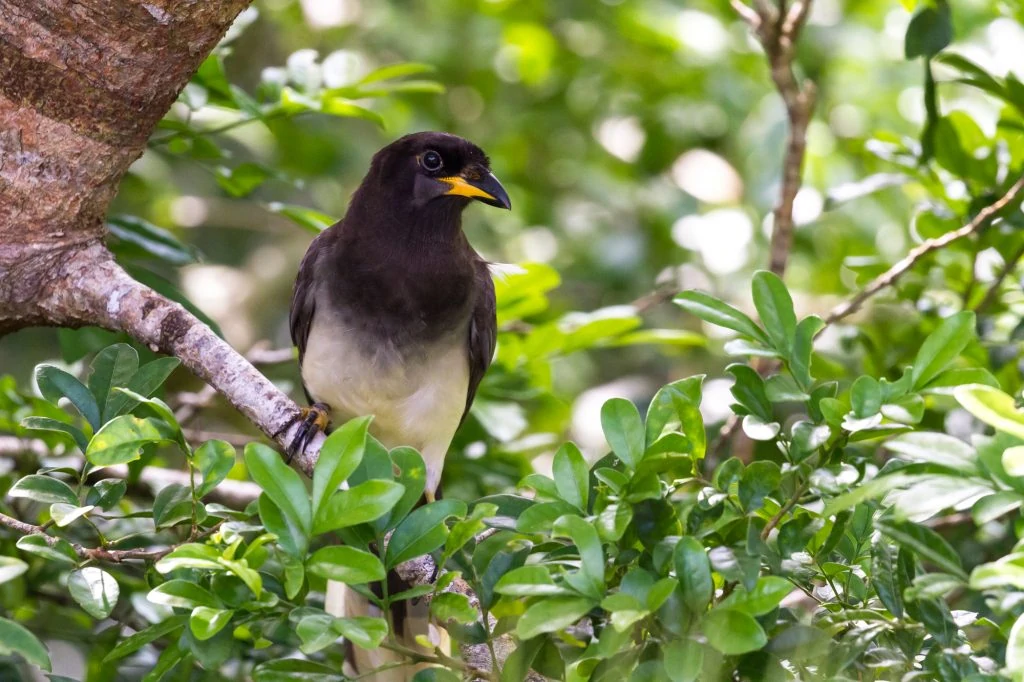
These highly intelligent and widely distributed birds called corvids or crows are known as the smartest birds and include colorful jays, large ravens, magpies, nutcrackers, and crows.
Crows are among the most intelligent of birds and show skills equivalent to a 7-year-old child. They make tools to get bugs out of crevices and even to fish with!
Crows are omnivores and will eat whatever is available and this can cause problems when they target trash and it can give them a bad reputation. They are also associated with death and bad omens in folklore.
There are 15 types of crows in Texas, but only 8 are regularly occurring and these include Blue Jays, American Crows, Green Jays, Common Ravens, Woodhouse’s Scrub-Jays, Chihuahuan Ravens, Fish Crows, Mexican Scrub-Jays, Steller’s Jays.
Love them or hate them they are fascinating birds to watch and so check out all the corvids in Texas.
15 Crows in Texas:
1. Blue Jay
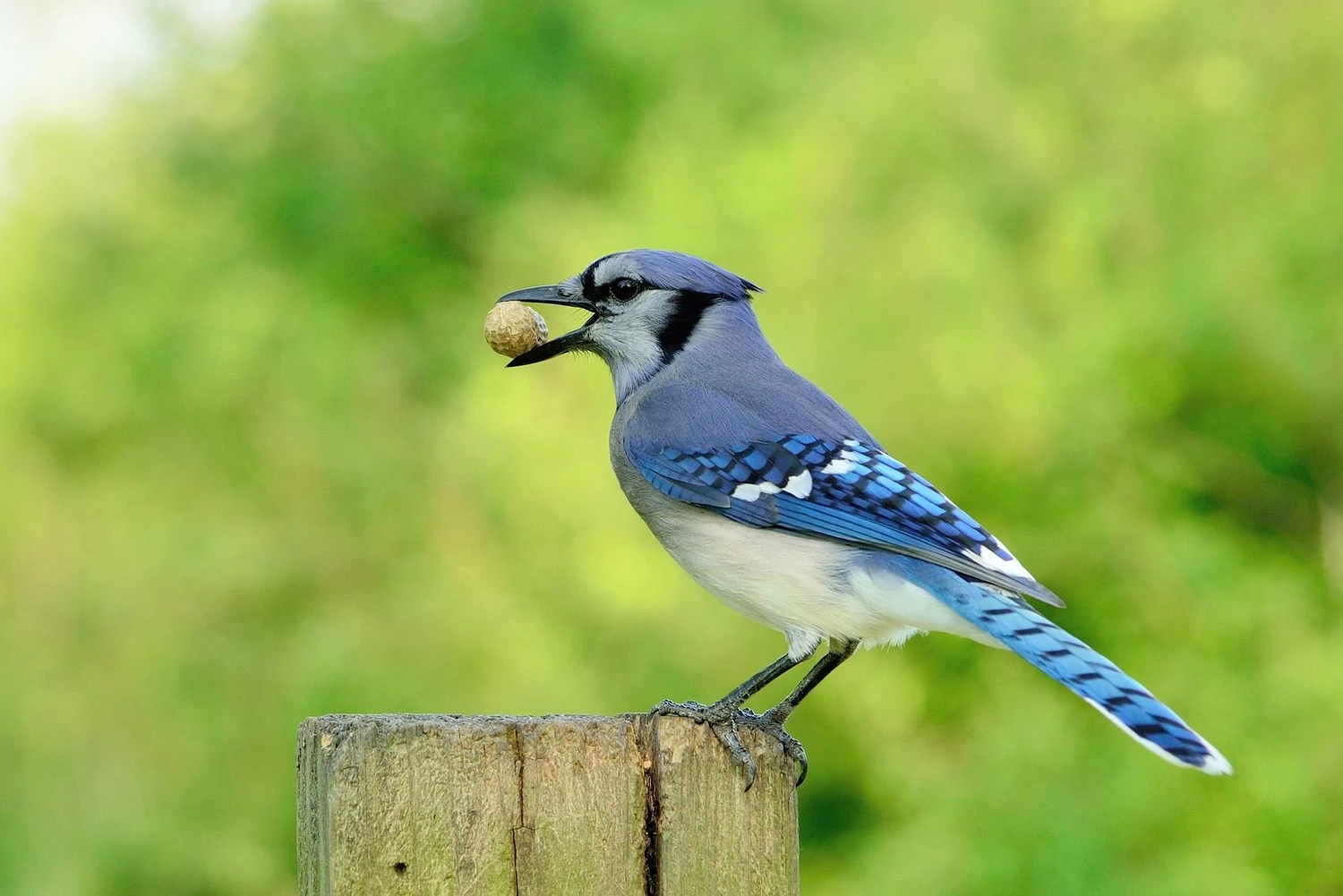
Blue Jays are spotted all year in Texas, especially in the east of the state. They are recorded in 27% of summer checklists and 24% of winter checklists submitted by bird watchers for the state.
Blue Jays are common large songbirds with a blue upright crest, blue and black backs, and white undersides.
- Cyanocitta cristata
- Length: 9.8-11.8 in (25-30 cm)
- Weight: 2.5-3.5 oz (70-100 g)
- Wingspan: 13.4-16.9 in (34-43 cm)
Blue Jays live in eastern US states and Southern Canada all year. Some birds will migrate west for winter but not very frequently.
They are noisy birds that travel in family groups eating acorns when available. They can be found in forests, especially near oak, as they eat acorns. They can also be found in backyards near feeders.
As well as acorns, they eat insects, nuts and seeds, and grain. They may also take eggs from nests or take nestlings.
Blue Jay sounds: They usually make a variety of quite harsh calls using clicks, peeps, ‘caws’, and whistles. Blue Jays also have a gentle fluted song during courtship.
Blue Jays are large birds and prefer to fly in, grab a peanut or sunflower seed and take it away to feed. They prefer platform or tray feeders to make it easy to make a quick exit.
Attract Blue Jays to your backyard with peanuts, sunflower seeds, and suet on tray feeders or hopper feeders on a post. They will also enjoy a birdbath.
Fun fact: Blue Jays will play with shiny objects such as aluminum or bottle caps, and they will carry them around, dropping them and picking them up.
2. American Crow
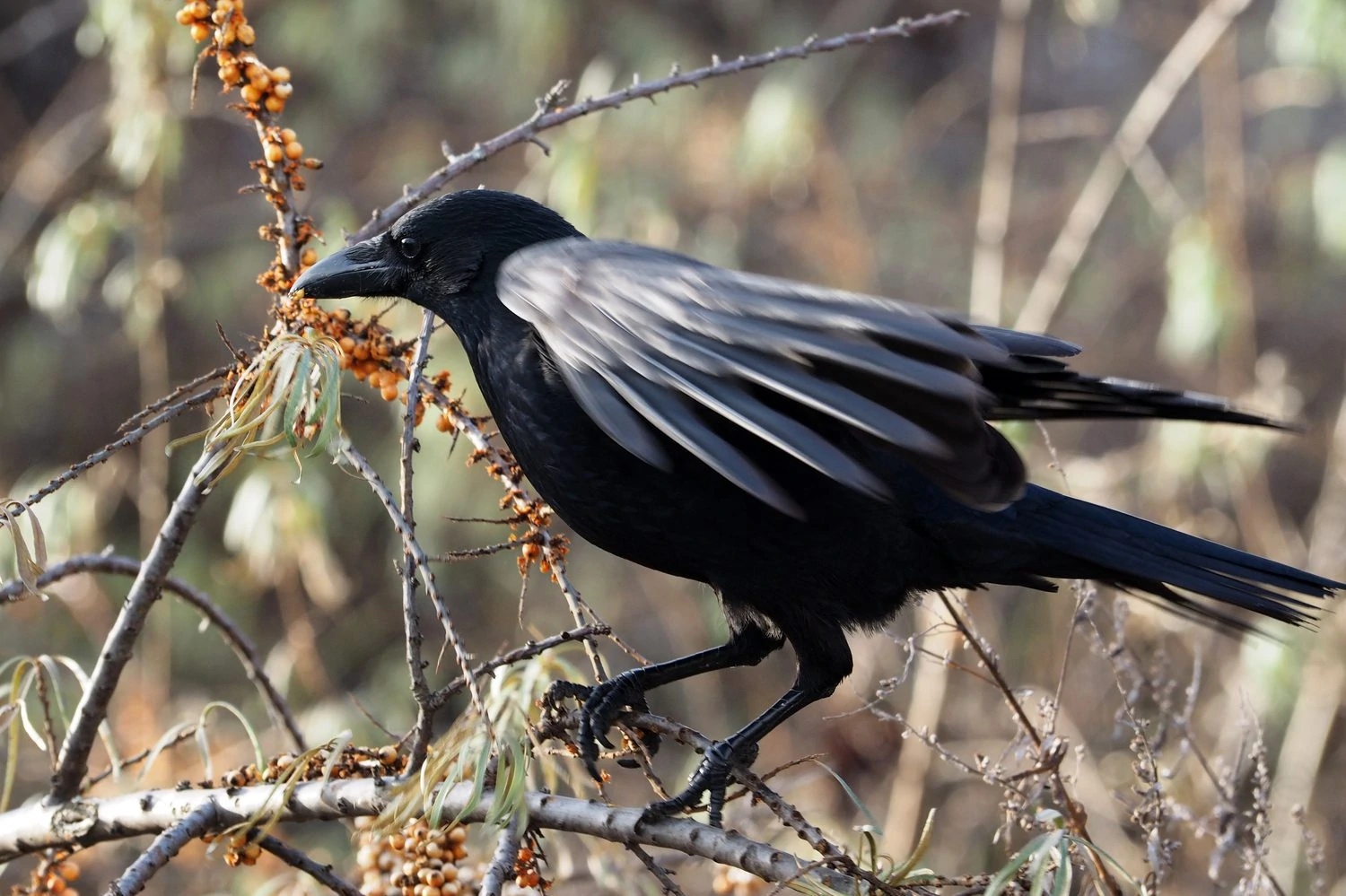
American Crows can be seen in Texas all year but are most common during fall, from September to December. They appear in 16% of summer checklists and 19% of winter checklists.
American crows are large all-black birds, including their legs and bills. They have slightly glossy feathers.
- Corvus brachyrhynchos
- Length: 15.8-20.9 in (40-53 cm)
- Weight: 11.2-21.9 oz (316-620 g)
- Wingspan: 33.5-39.4 in (85-100 cm)
American Crows are residents all year in the lower 48 and the Pacific Coast of Canada and Alaska. Those that breed in Canada and the northern Midwest migrate south for winter.
They are common birds that can be found in most habitats, including treetops, woods, fields, beaches, or towns.
They eat most things and usually feed on the ground, eating earthworms, insects, seeds, and fruit. They also eat fish, young turtles, mussels, and clams and will even eat eggs and nestlings of many species of birds.
American Crow Sounds: They make a hoarse, cawing sound
Nests of American Crows are usually high up in conifers and oak and are made from sticks. They lay 3 – 6 eggs, and these take just under three weeks to hatch and a further five weeks to fledge.
Attract American Crows to your backyard by scattering peanuts, but they can become a nuisance as attracted by garbage or pet food if left out.
Fun Fact: American Crows gather in large numbers of up to two million crows in winter to sleep in communal roosts.
3. Green Jay
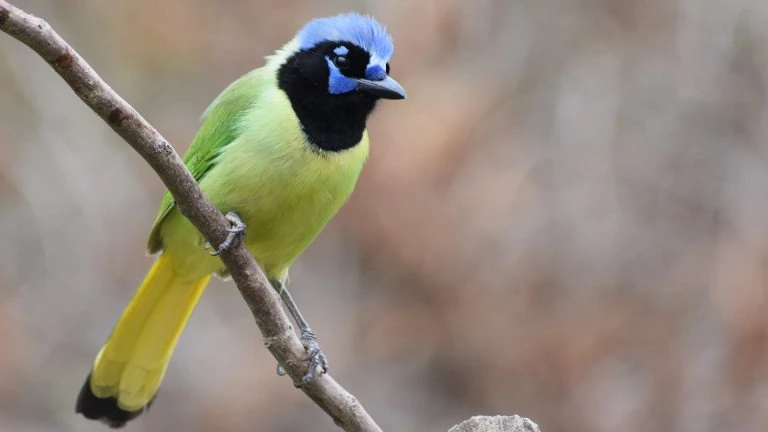
Green Jays are found in Texas all year, mainly in the south of the state. They are spotted in 2% of summer checklists and 7% of winter checklists.
Green Jays are a fantastic mix of bright green, blue, and black. They have dark green backs, paler bellies, and bright blue and black heads.
- Cyanocorax yncas
- Length: 11.4 in (29 cm)
- Weight: 2.3-3.9 oz (66-110 g)
This colorful Green Jay is a rare find in the US as they are only seen in southern Texas. They usually live along the coasts of Mexico, Central America, and South America.
You can find Green Jays in woodlands near streams and water, and they feed on insects, fruit, and seeds. If you are lucky, you may see one at bird feeders in Texan wildlife refuges.
Green Jay sounds: They make a variety of several fast calls that can be ‘Kaw’ like, buzzing, clicking, peeps and screams.
Nests of Green Jays are simple stick constructions lined with moss, leaves, and grass. Even their eggs have a greenish tint to them!
Fun facts: Green Jays are one of a few birds that can use tools, and they will use sticks to help pry up bark to get to food below.
4. Common Raven
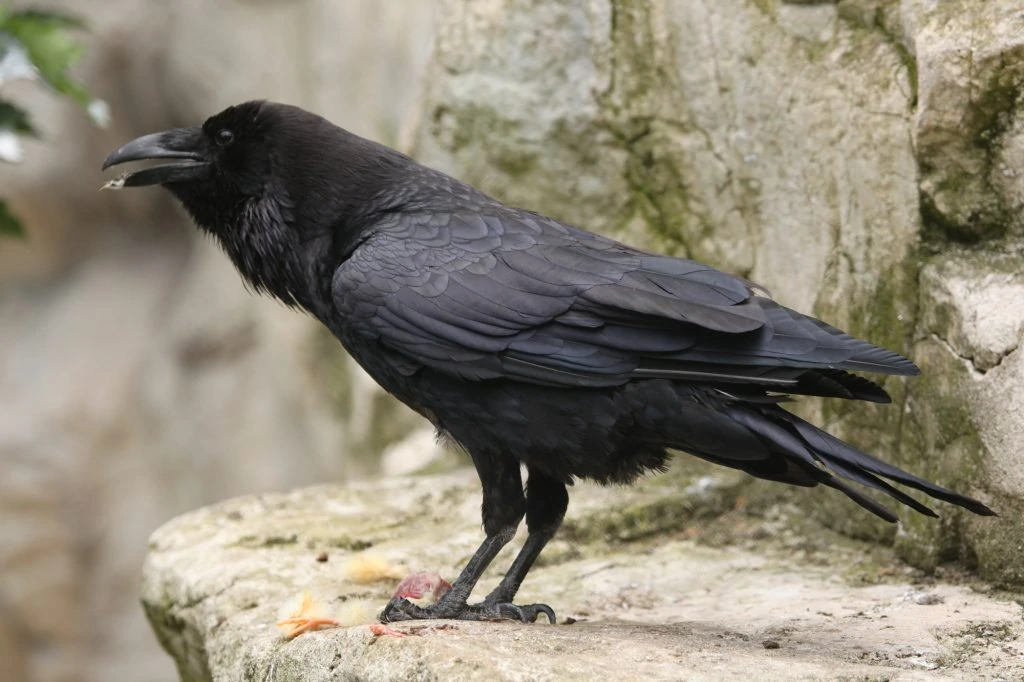
Common Ravens do not migrate and are spotted in Texas all year. They occur in 2% of summer and winter checklists.
Common Ravens are thought to be one of the smartest and definitely one of the largest species in the songbird family. They have shaggy throat feathers, large black beaks, and wedge-shaped tails.
- Corvus corax
- Length: 22.1-27.2 in (56-69 cm)
- Weight: 24.3-57.3 oz (689-1625 g)
- Wingspan: 45.7-46.5 in (116-118 cm)
Common Ravens are resident in Canada, western US states, northeastern US states, Mexico, and northern Central America. They are not found in the Great Plains or eastern US states.
You can find Common Ravens in most places, and they especially follow humans. Forests, beaches, fields, grasslands are all places to find them and rural human areas. They are not common in towns and cities as American Crows take over.
Not known as picky eaters, Common Ravens will eat most things, including any small animals, eggs and nestlings, plus insects and fish. Human rubbish and pet food
Common Raven sounds: Mostly croaks and harsh calls
Nests of Common Ravens are usually relatively high up on cliffs, trees, bridges, and towers. Their nests are made from long sticks and are large, up to 5 feet across and 2 feet high. The inside of the nest will be lined with mud and softer material, such as grass and wool.
Common Ravens lay up to seven eggs, and they take around three weeks to hatch and about five weeks to fledge.
Fun Fact: Common Ravens in Canada weigh up to 60% more than those in California.
5. Woodhouse’s Scrub-Jay
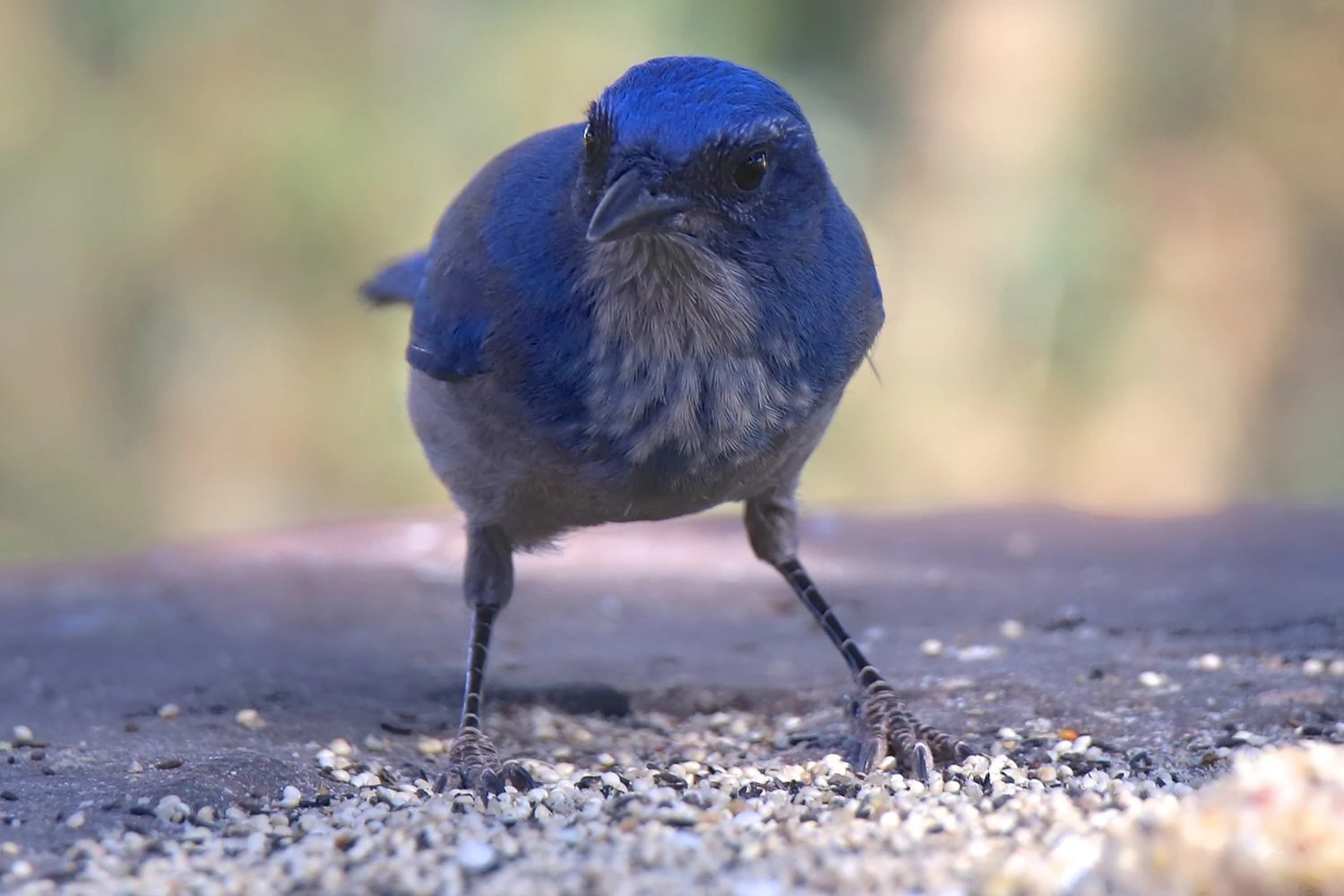
Woodhouse’s Scrub-Jays live in Texas all year and are usually spotted in the west and cental regions of the state. They are recorded in up to 2% of summer and winter checklists.
Woodhouse’s Scrub-Jays are the Blue-Jays of the Southwest with lovely blue and gray coloring. They are light blue and dark gray on the back and light gray underneath. Their tails are long and blue.
They are duller in color than California Scrub-Jays and have only a small necklace, and lack the crests of Blue Jays and Stellar’s Jays.
- Aphelocoma woodhouseii
- Length: 11.0-11.8 in (28-30 cm)
- Weight: 2.5-3.5 oz (70-100 g)
Woodhouse’s Scrub-Jays are resident inland in southwest US states and Mexico. You can find them in wooded areas with pinyon-juniper and scrubby areas.
Insects and fruit make up most of the diet of Woodhouse’s Scrub-Jays in summer and nuts and seeds in winter.
Woodhouse’s Scrub-Jay sounds:
Nests of Woodhouse’s Scrub-Jay are fairly simple platforms made of twigs and lined with moss and grass.
Attract Woodhouse’s Scrub-Jays to your backyard with sunflower seeds and peanuts.
Fun Fact: Woodhouse’s Scrub-Jays are thieves that steal food from other birds stores, especially Acorn Woodpeckers’ granary tree store of acorns.
6. Chihuahuan Raven
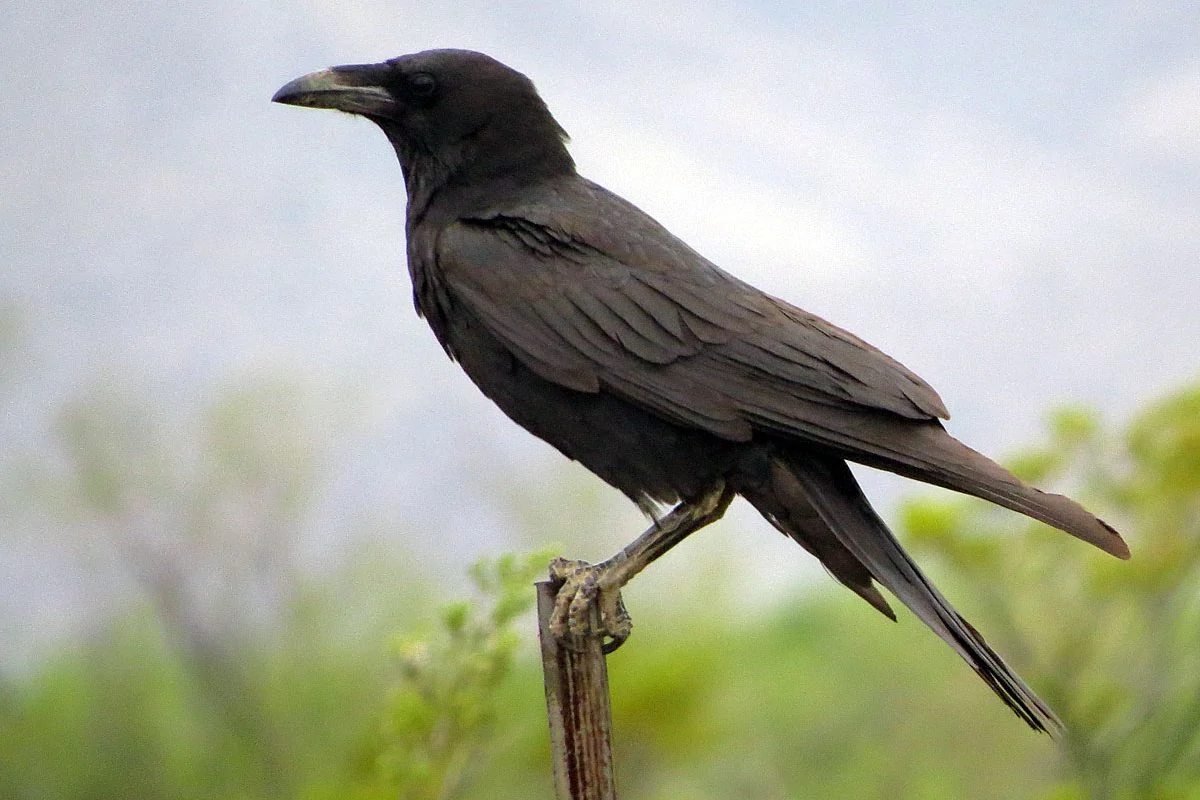
Chihuahuan Ravens are residents of Texas all year and are mainly spotted in the west of the state.
Chihuahuan Ravens are very similar in appearance to Common Ravens but with longer tails, and they are smaller and more similar in size to American Crows. They are all black, including the black bill and legs. They also have a slight glossy purple color.
- Corvus cryptoleucus
- Length: 18.1-20.9 in (46-53 cm)
- Weight: 15.6-23.5 oz (442-667 g)
- Wingspan: 40.9-43.3 in (104-110 cm)
Chihuahuan Ravens are resident in the American southwest from Arizona to Texas and northern Mexico.
You can find Chihuahuan Ravens in dry grassland and deserts where American Crows do not usually live.
They eat a wide variety of food and are opportunity feeders, often foraging on the ground for insects, worms, spiders, and fish, and larger roadkill prey such as reptiles and mammals. Grains, fruit, and seeds are also eaten, and they will happily eat trash for an easy meal.
Chihuahuan Raven sounds:
Nests of Chihuahuan Ravens are quite large and made from sticks, and lined with softer material such as feathers, cotton, and plant material.
They lay 1 – 8 eggs, and these take just under three weeks to hatch and a further five weeks before the chick fledge.
Fun Fact: Chihuahuan Ravens perform barrel rolls in flight during courtship.
7. Fish Crow
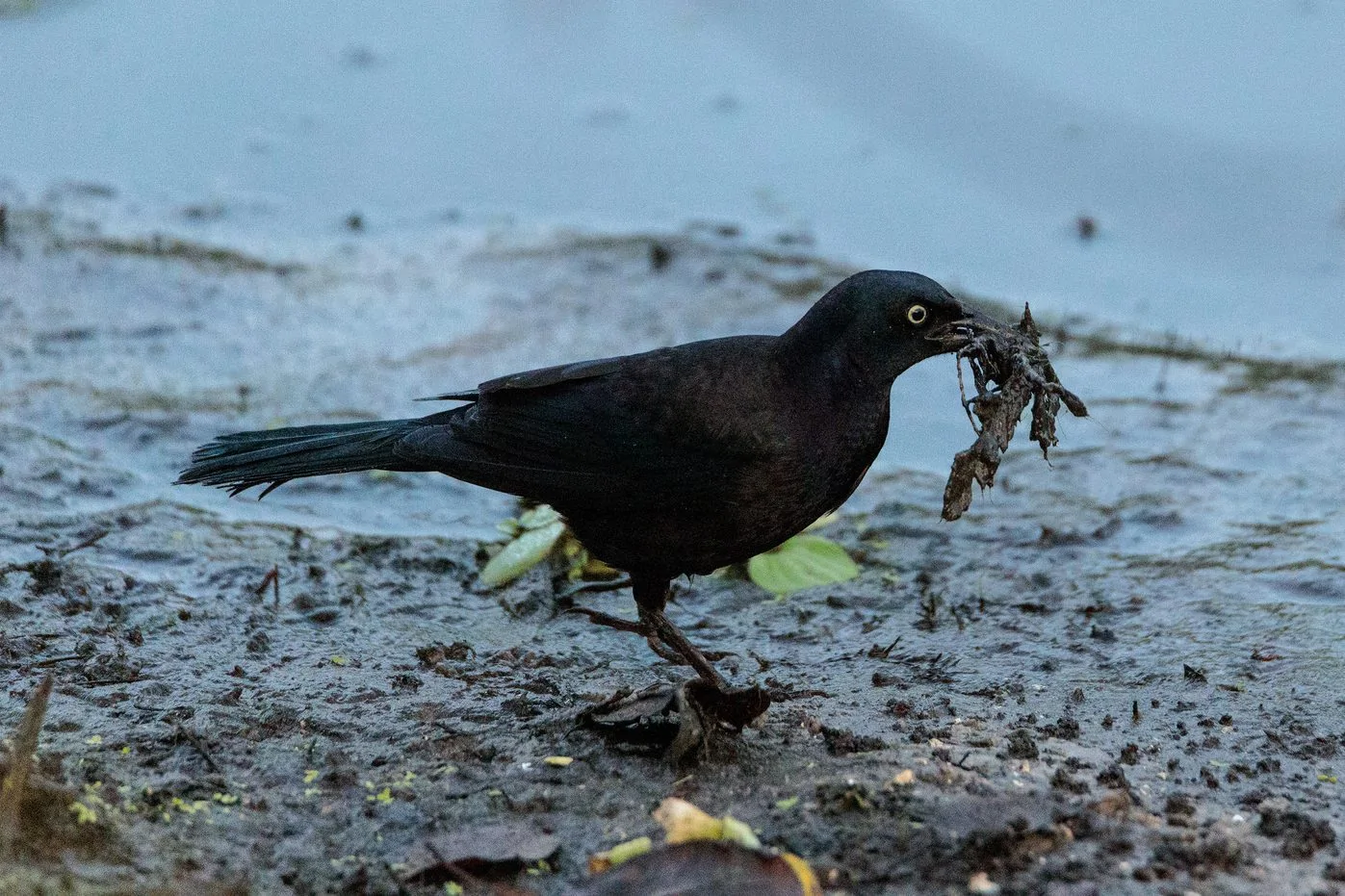
Fish Crows spend the breeding season in Texas, from March to August, but some also hang around all year. They are mainly spotted in the east of the state.
Fish Crows look the same as American Crows, with all black glossy coloring and strong, sturdy bodies. Only their calls are different. They have slightly rough throat feathers, which they puff out when calling. Males and females look the same.
- Corvus ossifragus
- Length: 14.2-15.8 in (36-40 cm)
- Weight: 6.9-11.6 oz (195-330 g)
- Wingspan: 33.1 in (84 cm)
Fish Crows are resident along the east coast from Texas up to Maine. They will occasionally move short distances in winter.
You can find Fish Crows near water, including beaches, rivers, and marshes. Like most crows, they are also often found near humans as they will eat most things, not just fish as their name would suggest. Grain, fruit, eggs, and baby birds, are all on the menu, as well as crabs and other marine life.
Fish Crow sounds: A typical crow ‘caw,’ but more nasal than the American Crow.
Nests of Fish Crows are in trees or mangroves and are made from bundles of sticks and filled with mud and softer material such as moss, pine needles, and bark.
They lay 2 – 6 eggs, and these take around two and a half weeks to hatch and a further four to five weeks to fledge.
Fun Fact: Fish Crows form massive, noisy flocks in their hundreds of thousands in winter.
8. Mexican Scrub-Jay
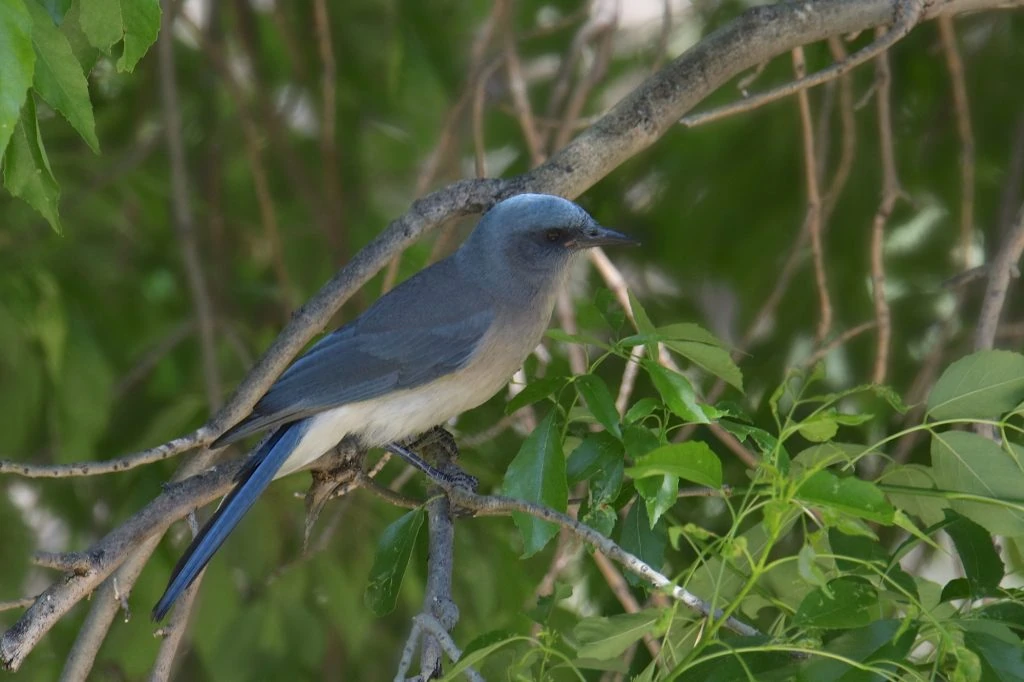
Mexican Scrub-Jays are recognized as regularly occurring in Texas and are mainly spotted around Big Bend National Park from mid-April to June but there are also a few sightings all year.
Mexican Jays are medium-sized, pale, bluish-gray birds. It is a lighter color compared to other jays and with a grayish upper neckline and chest. Its bill is small and black.
- Aphelocoma wollweberi
- Length: 11.4 in (29 cm)
- Weight: 4.2-4.8 oz (120-135 g)
You can find Mexican Jays in open oak and pine woods and forests.
Mexican Jays eat mostly insects, small reptiles, and other birds’ eggs and young. In the winter, they mainly eat acorns and pine nuts which they stored during the previous season.
Mexican Scrub-Jay sounds:
Nests of Mexican Jays are built by both males and females in trees and protected by thick leaves. The nests are built of sticks and twigs with a lining of rootlets and plants.
They lay around five eggs that take about eighteen days to hatch. The young leave the nest after about twenty-five days, but they may be cared for by the flock for several weeks.
Fun Fact: Northern Flickers usually follow Mexican Jays in flight during migration because they use the loud, shrill voices of the Mexican Jay to warn themselves of any predators.
9. Steller’s Jay
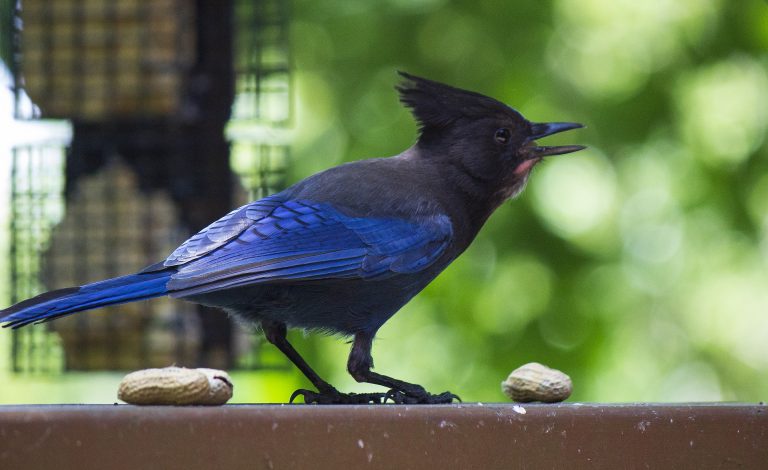
Steller’s Jays are not very common in Texas but some have been spotted in the northwest of the state all year.
Steller’s Jays are large songbirds with black triangular crests that stick up from their heads. The rest of their heads and onto their chests and back are black, with the rest of their bodies being blue.
- Cyanocitta stelleri
- Length: 11.8-13.4 in (30-34 cm)
- Weight: 3.5-4.9 oz (100-140 g)
- Wingspan: 17.3 in (44 cm)
Steller’s Jays are resident in western US states, western Canada, Mexico, and Central America.
You can find Steller’s Jays in evergreen forests in the mountains, and they will also be found around picnic tables, campgrounds, and backyard feeders.
Steller’s Jays eat most things they can forage for, including insects, seeds, nuts, berries, eggs, and nestlings, but also making a nuisance of themselves around garbage and your unguarded picnic!
Steller’s Jay sounds: They make ‘kaw’ sounds as well as fast two-toned calls, peeps, and harsh guttural sounds. Steller’s Jays can also mimic other noises such as other bird species and even sprinklers and alarms.
Nests of Stellar’s Jays are usually near the top of conifer trees and are built from leaves and plant material held together with mud and lined with soft pine needles.
Attract Steller’s Jays to your backyard with peanuts and suet.
Fun fact: Stellar’s Jays make nests out of the mud.
10. Brown Jay

Brown Jays are extremely rare in Texas and are considered accidental species in the state. They were last spotted around Chapeno and Salineno in 2012.
Brown Jays are large birds that can be completely dark brown with a lighter tint on the back, or in some Southern species, their bellies are white, and they have white tips to their tail feathers.
Adults have black bills, legs, and feet, but the young have yellow legs and eyering.
- Psilorhinus morio
- Length: 15 – 17 in (38.1 – 43.2 cm)
- Weight: 7 oz (198.4 g)
Brown Jays are usually found in Mexico and Central America, but they are also found in Texas at the north of their range.
You can find Brown Jays in dense woodland with tall trees and near to water.
Brown Jays are omnivorous, so they will feed on insects and rodents as well as berries, fruits, seeds, and nectar. They will find food on the ground but may also hop from branch to branch.
Brown-Jay sounds:
A flock of Brown Jays share communal nests located in a forked branch of a tree or a low-lying shrub. Several adults put together sticks and twigs to make the cup of the nest, and they line it with weeds and other soft materials for the eggs.
They lay up to eight eggs which take around twenty days to hatch. After hatching, the young leave the nest in about four weeks.
Fun Fact: The Brown Jay is the largest North American Jay.
11. Tamaulipas Crow

Tamaulipas Crows are considered rare or accidental species in Texas but there have been occasional sightings in the southeast of the state. They were last spotted around Brownsville in 2021.
Tamaulipas Crows are slender, bluish-black crows. Their feathers appear soft and glossy, and their bills, legs, and feet are black.
- Corvus imparatus
- Length: 13 – 15 in (34 – 38 cm)
- Weight: 8 – 9 oz (192 – 237 cm)
You can find the Tamaulipas Crow around farms, towns, and villages. They also inhabit dry, desert-like areas and bushland. Tamaulipas Crows and their flock also love to stay in tall trees.
Tamaulipas Crows are great scavengers of food and trash and that’s why they stay within small towns. They eat carrion, insects, berries, nuts, other birds’ eggs, nestlings, and other food they come across.
Nests of Tamaulipas Crows can often be seen in open areas, usually in high locations, like trees. In suburban areas, any open, high location is fair game, so there have been sightings of nests on open steel beams.
Tamaulipas Crow sounds:
The nests are made with sticks and plant fibers with softer material to line the inside. They lay around five eggs which take about eighteen days to hatch. Their young may leave the nest around five weeks after hatching.
Fun Fact: The voice of Tamaulipas Crow sounds like that of a frog croaking.
12. Pinyon Jay
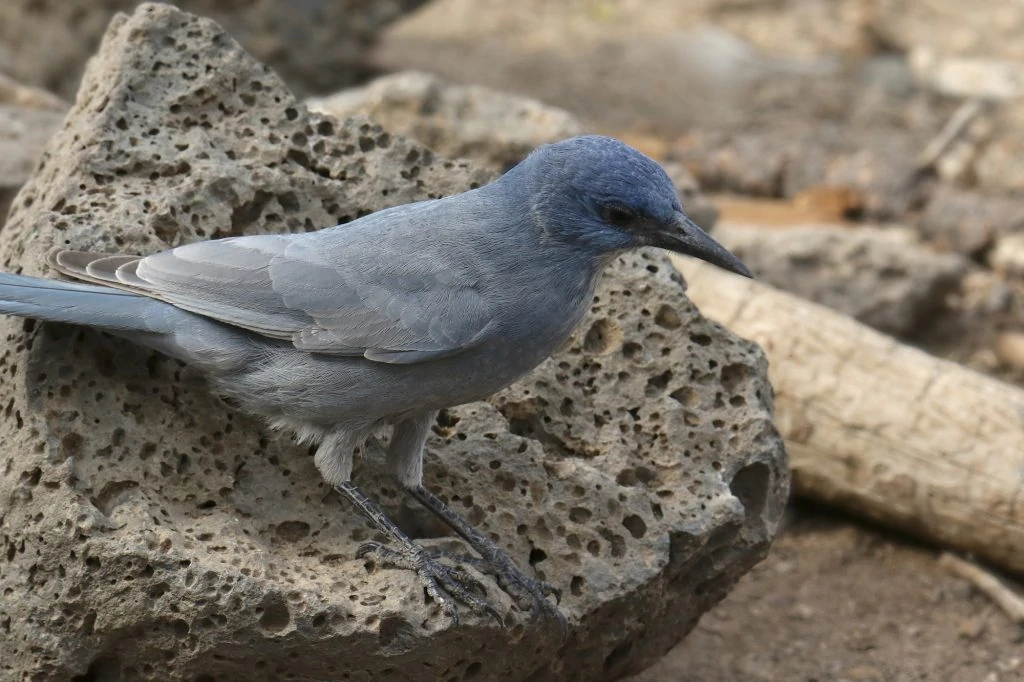
Pinyon Jays are considered vulnerable and accidental species in Texas but they have been spotted in the west of the state.
Pinyon Jays are blue all over, with darker backs and paler bellies. They also have white throats, shorter tails, and do not have crests like other Jays, like Stellar’s Jays. Males and females look the same, but juveniles can look more grayish-blue.
- Gymnorhinus cyanocephalus
- Length: 10.2-11.4 in (26-29 cm)
- Weight: 3.2-4.2 oz (90-120 g)
- Wingspan: 18.1 in (46 cm)
Pinyon Jays are residents inland in western US states in pinyon-pine forests.
As well as seeds from pinyon-pine, Pinyon Jays will eat juniper berries, acorns, and other animals such as lizards, baby birds, and insects. They are opportunity feeders who will take most things and forage in large, noisy groups.
Pinyon Jay sounds: They make 3 ‘kaw’ like calls close together that rise and then fall and sometimes shake or tremble.
Nests of Pinyon Jays are built of sticks and grass in pine trees and lined with feathers and animal hair.
Fun fact: Pinyon Jays do not have feathers over their nostrils to prevent the sticky pine pitch from making them dirty.
13. Clark’s Nutcracker
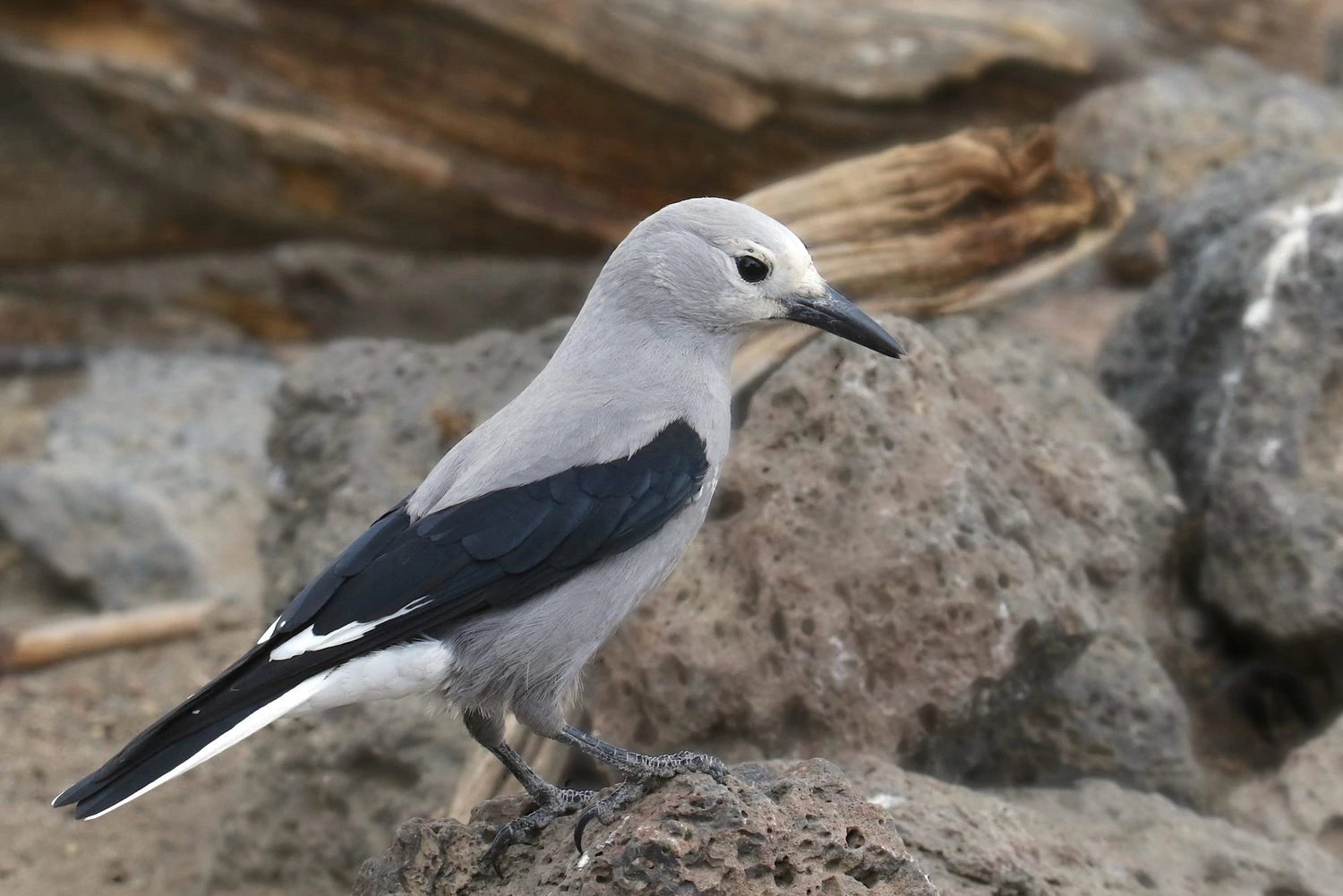
Clark’s Nutcrackers are extremely rare in Texas and are considered accidental species in the state. They were last spotted around Alpine in 2020.
Clark’s Nutcrackers are similar in appearance to Canada Jays, with the gray coloring. They have shorter tails than jays and lack the crest. Clark’s Nutcrackers are light gray with black wings and tails with white patches.
- Nucifraga columbiana
- Length: 10.6-11.8 in (27-30 cm)
- Weight: 3.7-5.7 oz (106-161 g)
Clark’s Nutcrackers can be found all year in the pine forests of the mountainous west. They do not migrate but do move up to higher altitudes in the summer, and if pine crops are poor, they will move large distances.
Clark’s Nutcrackers mainly eat pine seeds fresh from the tree or those they have hidden away previously. They will occasionally eat insects, spiders, or small mammals if they get a chance.
Clark’s Nutcracker sounds:
Nests of Clark’s Nutcrackers are made in conifer trees and are made from sticks and twigs and lined with wood pulp, followed by soft dry grass and moss.
They lay 2 – 6 eggs, and these take around two and a half weeks to hatch and a further three weeks to fledge.
Attract Clark’s Nutcrackers to your backyard with black oil sunflower seeds, peanuts, and suet.
Fun Fact: Clark’s Nutcrackers have been recorded as far as Northeastern US states, when cone crops are poor, a distance of up to 2000 miles!
14. Black-throated Magpie-Jay
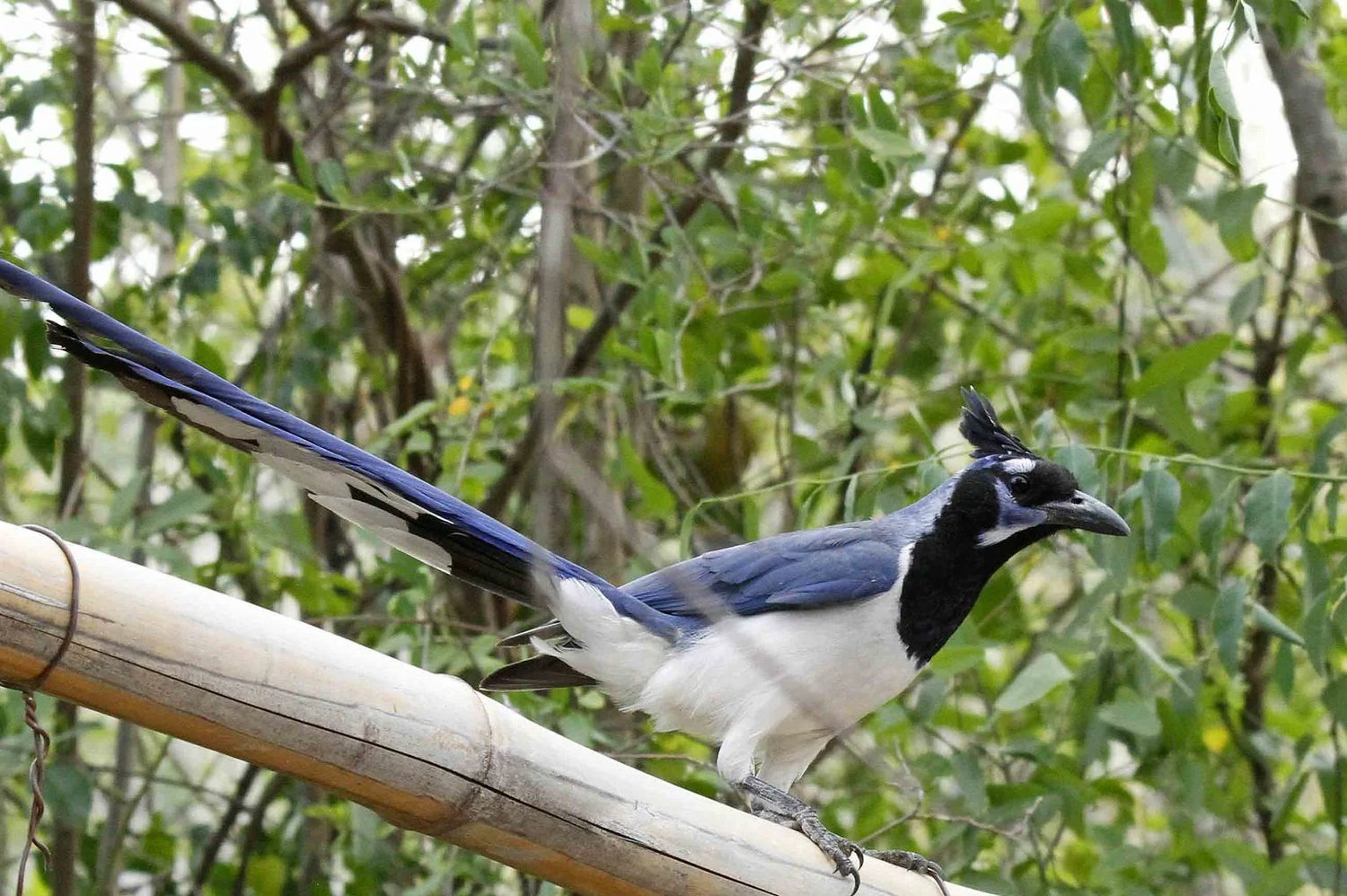
Black-throated Magpie-Jays are non-native species in Texas and they were last spotted around Estero Llano Grande State Park in 2009.
The striking Black-Throated Magpie Jay is a large, long-tailed bird. It has a conspicuous black crest and throat, a patch of blue on its eyebrows and under the eye, blue wings, a white-tipped tail, and a white underside.
In the south of their range, their throats are more white with a thinner black band.
- Calocitta colliei
- Length: 23 – 30 in (58.5 – 76.5 cm)
- Weight: 8 – 9 oz (225 – 251 cm)
You can find Black-throated Magpie Jays around tropical lowland forests, plantations, and partially open areas with tall trees and hedges. They are not particularly fond of humid woodlands, though.
Typical of a crow family, a Black-throated Magpie Jay eats both plants and animals. It loves seeds and nuts but is also known to eat insects and other smaller birds.
Black-throated Magpie-Jay sounds:
Black-throated Magpie-Jays nest is usually created with sticks and twigs but lined with some soft material, and they lay up to seven eggs.
Fun Fact: Black-throated Magpie Jay eats standing up. One foot is used to hold on to the food while the other foot puts food in its mouth.
15. Black-billed Magpie
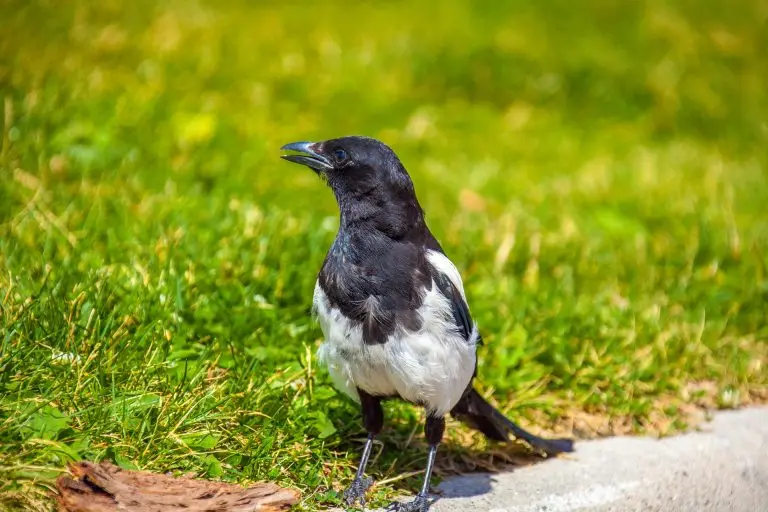
Black-billed Magpies are accidental species in Texas. They are extremely rare in the state and were last spotted around Adcock Ranch in 2017.
Black-billed Magpies, usually just called Magpies, are black and white birds that are noisy. They have long tails and blue-green iridescent flashes in the wing and tail. Males are up to 25% heavier than females.
- Pica hudsonia
- Length: 17.7-23.6 in (45-60 cm)
- Weight: 5.1-7.4 oz (145-210 g)
- Wingspan: 22.1-24.0 in (56-61 cm)
Black-billed Magpies live in northwestern US states and western Canada, and the coast of Alaska. They do not migrate.
You can find them walking on the ground in meadow and grasslands or other open areas feeding on fruit and grain, beetles, and grasshoppers. They have also been known to kill small mammals such as squirrels and voles and raid bird nests for eggs or nestlings and even carrion.
Black-billed Magpie sounds: A series of harsh calls and also a scream.
Nests of Black-billed Magpies are a messy ball-shaped collection of twigs with a neat cup of mud and soft material on the inside. They lay 6 – 7 eggs, and these take around three weeks to hatch and fledge a further 3 – 4 weeks.
You can attract Black-billed Magpies to your backyard with platform and suet feeders with black oil sunflower seeds, peanuts, fruit, suet, millet, and milo.
Fun Fact: A gathering of magpies calling around one of their dead is called a funeral.

